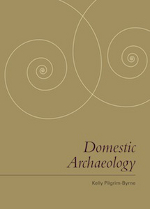
Domestic Archaeology by Kelly Pilgrim-Byrne
Grand Parade Poets, 2012
In her second poetry collection, Domestic Archaeology, Perth-based poet Kelly Pilgrim-Byrne mines a personal narrative with mixed results. While she manages to achieve interesting self-awareness in some of these confessional poems, others lack such clarity and humour.
The book’s opening poem studies icons of the Venus of Willendorf, a symbol of pre-modern fertility: a sideways introduction to the poet’s own story of IVF treatment, conception and same-sex parenthood. It anticipates how Pilgrim-Byrne’s book will poetically approach the subject of modern fertility – not only by telling her story but by considering the ‘archaeology’ of its traces through themes of creativity, inheritance, intimacy and separation. The book’s three sections – ‘Excavation’, ‘Fauna’ and ‘Cataloguing’ – move outwards from emotional confession to meditations on a broader ecology of animal life and death.
In his review of Domestic Archaeology, Michael Farrell concludes that Pilgrim-Byrne doesn’t believe in the ‘meanness’ of life. I find, however, that the strongest poems in the collection are those in which the speaker admits this streak in herself. It’s a particularly important element within the scope of ‘Excavation’, which charts the frustration, envy and desire of infertility before the peace and satisfaction of motherhood. For example, whilst the aforementioned poem, ‘Venus of Willendorf’, accretes earth-mother imagery in praise of the powerful icon, the poem ends with a turn to the deflated, ‘hollow’ body of the childless speaker, still clutching her rotund little homunculus. This turn recurs in the following poem, ‘Infertility: four vignettes’, in which the speaker – both righteous and self-parodying – confesses to wanting to snatch babies and ‘tear away with them to our mecca / where barren woman meet at harvest time to rub fertility goddesses.’ With a bittersweet sneer, the poem ridicules the idea of entitlement: ‘These babes would be ours, kept hidden from the ungrateful.’ Later in the suite, she succinctly communicates an awareness of the incongruity and desperation of fertility magic:
Beneath the soil, under a bottlebrush tree a chicken’s egg is buried—drawn on with green paint, symbols of an ancient alphabet which spell ripe yet speak of putrid decay. (‘Infertility: four vignettes’)
Furthermore, this sequence represents IVF treatment just as coolly. With unblinking observation of its clinical motions, Pilgrim-Byrne chooses effectively unromantic phrasing to describe the procedure: the doctor ‘sloshes a cold solution over my snatch / then calls, Ready’, followed by a long, enjambed sentence in which, ‘The technician carries my baby in a tube across the room / hands it to the doctor who in turn feeds it to me.’ Impressively, Pilgrim-Byrne manages this tonal teetering from heartfelt to hurt; hopeless to hopeful.
Thus, she does not slavishly document the real time of her personal narrative, but rather, Pilgrim-Byrne has selected poems not only for their narrative significance but also for the variety and balance they bring to the collection. For this reason I feel uneasy about framing the book in terms of authenticity. Its cover blurb, press release and author note all make a point of detailing Pilgrim-Byrnes’ story as though it were a footnote to every poem in the collection. But what if the ‘Excavation’ poems were read as dramatic monologues, fictional constructions? I’m not suggesting that Pilgrim-Byrne’s poems are fictional, but rather, that when we place emphasis on the poet’s narrative we might miss the strengths and weaknesses of the poems’ technique. Pilgrim-Byrne alludes to Plath more than once in Domestic Archaeology, as though hinting that the performance of the self might be as valuable to poetic life writing as emotional faithfulness and narrative linearity.
The keen sense of poetic craft with which Pilgrim-Byrne introduces her book is also evident at other interesting points in this collection. There is enjoyment to be found in the tangential vision of the second section, ‘Fauna’. Here, Pilgrim-Byrne draws in new subjects of domestic experience, which inevitably reflect and are reflected by the establishing theme of motherhood: meat production (‘Cows in My Street’), colonies (‘Bees’), and extermination (‘Clinic’). The book’s third and final section, ‘Cataloguing’, goes further as the poet frequently estranges her poetic voice from herself. Its centrepiece, ‘Juvenescence, variations on a theme’, is possibly the collection’s most exciting treatment of voice and form. Its theme is broad enough to escape a linear narrative; bringing together episodes or sketches of youth, which is shown as it pulses inside of culture. One can’t always identify the suite’s specific cultural scenarios of time and place – an affect of suspension that is quite separate from the confessional mode of the book’s earlier parts:
On the backs of horses a young girl discovers herself This time of year is Darwin weather unpredictable as nightmares A cyclone spots her in the distance rages, rushes toward her she squeezes her thighs against the honey-washed beast a last minute thrill then the ride is over. (‘West’, from ‘Juvenescence, variations on a theme’)













